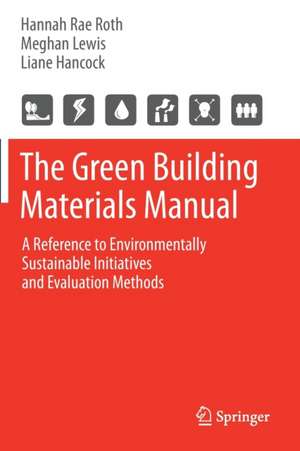The Green Building Materials Manual: A Reference to Environmentally Sustainable Initiatives and Evaluation Methods
Autor Hannah Rae Roth, Meghan Lewis, Liane Hancocken Limba Engleză Paperback – 29 mar 2022
This book breaks down the technical vocabulary and principles that define environmentally sustainable choices across interior and exterior architectural products to help the reader understand:
- Material ingredient selection
- Energy and water use
- Emissions, including greenhouse gases
- Human health and toxicity
- Social accountability assessment
| Toate formatele și edițiile | Preț | Express |
|---|---|---|
| Paperback (1) | 416.54 lei 43-57 zile | |
| Springer International Publishing – 29 mar 2022 | 416.54 lei 43-57 zile | |
| Hardback (1) | 490.79 lei 43-57 zile | |
| Springer International Publishing – 25 mar 2021 | 490.79 lei 43-57 zile |
Preț: 416.54 lei
Nou
Puncte Express: 625
Preț estimativ în valută:
79.72€ • 82.92$ • 65.81£
79.72€ • 82.92$ • 65.81£
Carte tipărită la comandă
Livrare economică 14-28 aprilie
Preluare comenzi: 021 569.72.76
Specificații
ISBN-13: 9783030648909
ISBN-10: 3030648907
Pagini: 194
Ilustrații: XV, 194 p. 32 illus.
Dimensiuni: 155 x 235 x 16 mm
Greutate: 0.3 kg
Ediția:1st ed. 2021
Editura: Springer International Publishing
Colecția Springer
Locul publicării:Cham, Switzerland
ISBN-10: 3030648907
Pagini: 194
Ilustrații: XV, 194 p. 32 illus.
Dimensiuni: 155 x 235 x 16 mm
Greutate: 0.3 kg
Ediția:1st ed. 2021
Editura: Springer International Publishing
Colecția Springer
Locul publicării:Cham, Switzerland
Cuprins
Chapter 1. Introduction.- Chapter 2. Describing Building Materials & Products.- Chapter 3. Life Cycle Thinking.- Chapter 4. Resource Use.- Chapter 5. Energy Use.- Chapter 6. Water Use.- Chapter 7. Emissions.- Chapter 8. Toxicity and Human Health.- Chapter 9. Social Accountability.- Chapter 10. Laws and Regulation; Standards, Certifications and Ecolabels.- Chapter 11. Transparency.- Chapter 12. Conclusion.
Notă biografică
Hannah Rae Roth was a Lecturer in Architecture and Environmental Studies at Washington University in St. Louis until mid-2020. She provides a deep focus on the environmental impact of building materials and architectural finishes, the regional nature of materials, and their vernacular use. She is an active member of the Missouri Gateway Chapter of the U.S. Green Building Council's Board and Education Committee, where she has created several programs on architectural building materials. She has in-depth knowledge of the design process, decision making process, contracting, purchasing and construction processes for large complex buildings such as hospitals and digital fabrication facilities. Ms. Roth received a Master of Architecture (M.Arch) degree from Washington University in St. Louis.
Meghan Lewis is a Senior Researcher at the Carbon Leadership Forum, where she leads policy and procurement research focused on reducing embodied carbon in building materials and construction. Previous to joining the Carbon Leadership Forum, Meghan was the Head of Global Energy & Sustainability at WeWork, where she launched the Supply Chain Sustainability program in 2018. Meghan gained her architectural license while practicing at Mithun in Seattle, Washington. Meghan is the Chair of the Buildings Focus Group of the Carbon Leadership Forum and was a contributing editor to the Practice Guide for the Life Cycle Assessment of Buildings. She received her Master of Architecture and Master of Environmental Management from Yale University.
Liane Hancock is an Associate Professor of Architecture in the School of Architecture and Design at the University of Louisiana at Lafayette. Previous to joining the University of Louisiana at Lafayette faculty, she taught at Washington University in St. Louis and was an Associate Professor at Louisiana Tech University. At Louisiana Tech she served as the foundation design coordinator for architecture within the School of Design. Her primary areas of research are on materials and construction methods. In particular, she has focused on both historical and contemporary use of reinforced concrete. Ms. Hancock holds degrees in architecture from MIT and Columbia University.
Meghan Lewis is a Senior Researcher at the Carbon Leadership Forum, where she leads policy and procurement research focused on reducing embodied carbon in building materials and construction. Previous to joining the Carbon Leadership Forum, Meghan was the Head of Global Energy & Sustainability at WeWork, where she launched the Supply Chain Sustainability program in 2018. Meghan gained her architectural license while practicing at Mithun in Seattle, Washington. Meghan is the Chair of the Buildings Focus Group of the Carbon Leadership Forum and was a contributing editor to the Practice Guide for the Life Cycle Assessment of Buildings. She received her Master of Architecture and Master of Environmental Management from Yale University.
Liane Hancock is an Associate Professor of Architecture in the School of Architecture and Design at the University of Louisiana at Lafayette. Previous to joining the University of Louisiana at Lafayette faculty, she taught at Washington University in St. Louis and was an Associate Professor at Louisiana Tech University. At Louisiana Tech she served as the foundation design coordinator for architecture within the School of Design. Her primary areas of research are on materials and construction methods. In particular, she has focused on both historical and contemporary use of reinforced concrete. Ms. Hancock holds degrees in architecture from MIT and Columbia University.
Textul de pe ultima copertă
Evaluating building materials for environmental sustainability is a complex prospect. How do governmental agencies and the design industry actually measure sustainable initiatives and environmental impacts?
This book breaks down the technical vocabulary and principles that define environmentally sustainable choices across interior and exterior architectural products to help the reader understand:
This book breaks down the technical vocabulary and principles that define environmentally sustainable choices across interior and exterior architectural products to help the reader understand:
- Material ingredient selection
- Energy and water use
- Emissions, including greenhouse gases
- Human health and toxicity
- Social accountability assessment
Caracteristici
Decodes ways to measure and evaluate building materials and architectural products for environmental sustainability Easy to understand icons and diagrams distinguish environmental and social impacts: material ingredients, energy, water, emissions, toxicity, and social accountability A timeline and short historical narratives add interest and contextualize information
